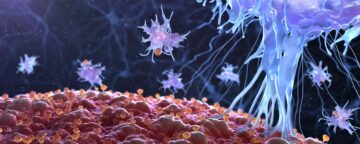Kamal Nahas in The Scientist:
 The immune system discriminates between the body’s own cells and foreign invaders largely by auditing proteins. Cells digest proteins into short fragments and load them onto the major histocompatibility complex (MHC), which presents the peptide to T cells for inspection. Using a parallel strategy, cells can also present lipids to T cells via a protein called cluster of differentiation 1 (CD1).1 Although scientists knew of the existence of lipid antigens, most immunology research has focused on protein antigens, leaving much to demystify about the role of CD1 and lipids.
The immune system discriminates between the body’s own cells and foreign invaders largely by auditing proteins. Cells digest proteins into short fragments and load them onto the major histocompatibility complex (MHC), which presents the peptide to T cells for inspection. Using a parallel strategy, cells can also present lipids to T cells via a protein called cluster of differentiation 1 (CD1).1 Although scientists knew of the existence of lipid antigens, most immunology research has focused on protein antigens, leaving much to demystify about the role of CD1 and lipids.
In a study spanning 14 years, a team of immunologists took on the challenge of characterizing CD1. Published in the journal Cell, they showed that CD1 can onboard hundreds of lipids to present to T cells.2 “We’ve never had such an in-depth map of the CD1 lipidome available,” said Patricia Barral, an immunologist at King’s College London who was not involved with the work. “It will enable us to start thinking about different types of lipids that may function as activatory or as inhibitory lipids, and whether they can control T cell responses in different contexts.”
More here.
